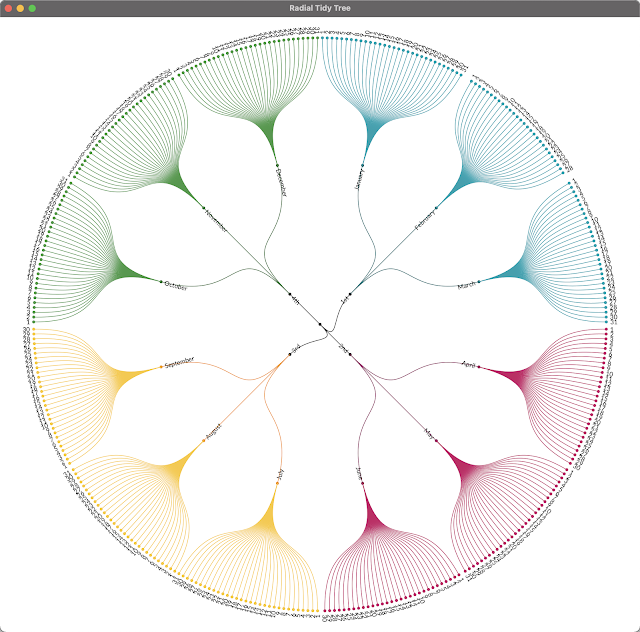JavaFinder
Do you ever wondered how many Java distributions you have installed on your machine? I not only mean versions that you use for development but also versions that come bundled with an application. Last weekend I've decided to write a little tool that can help me figuring that out...JavaFinder.
This is a simple command line tool that will search a given path including it's subfolders for any OpenJDK distribution or GraalVM derivate. So it's nothing really fancy but could be useful sometimes.
Usage
Per default it will print all distributions found in json format on the console, when I run it on my Macbook Pro without any parameters like this javafinder, the output will look as follows
{
"search_path":"/System/Volumes/Data/Library/Java/JavaVirtualMachines",
"sysinfo":{
"operating_system":"macos",
"architecture":"arm64",
"bit":"64"
},
"distributions":[
{
"vendor":"Azul",
"name":"Zulu",
"version":"17.0.7",
"path":"/System/Volumes/Data/Library/Java/JavaVirtualMachines/zulu-17.jdk/zulu-17.jdk/Contents/Home/",
"build_scope":"OpenJDK"
},
{
"vendor":"Azul",
"name":"Zulu",
"version":"8.0.372+7",
"path":"/System/Volumes/Data/Library/Java/JavaVirtualMachines/zulu-8.jdk/zulu-8.jdk/Contents/Home/jre/",
"build_scope":"OpenJDK"
},
{
"vendor":"Azul",
"name":"Zulu",
"version":"8.0.372+7",
"path":"/System/Volumes/Data/Library/Java/JavaVirtualMachines/zulu-8.jdk/zulu-8.jdk/Contents/Home/",
"build_scope":"OpenJDK"
},
{
"vendor":"Azul",
"name":"Zulu",
"version":"11.0.19",
"path":"/System/Volumes/Data/Library/Java/JavaVirtualMachines/zulu-11.jdk/zulu-11.jdk/Contents/Home/",
"build_scope":"OpenJDK"
},
{
"vendor":"Azul",
"name":"Zulu",
"version":"20.0.1",
"path":"/System/Volumes/Data/Library/Java/JavaVirtualMachines/zulu-20.jdk/zulu-20.jdk/Contents/Home/",
"build_scope":"OpenJDK"
},
{
"vendor":"Oracle",
"name":"Graal VM CE",
"version":"22.3.1",
"path":"/System/Volumes/Data/Library/Java/JavaVirtualMachines/graalvm-ce-java17-22.3.1/Contents/Home/",
"build_scope":"GraalVM"
},
{
"vendor":"Azul",
"name":"Zulu",
"version":"21-ea+21",
"path":"/System/Volumes/Data/Library/Java/JavaVirtualMachines/zulu-21.jdk/zulu-21.jdk/Contents/Home/",
"build_scope":"OpenJDK"
},
{
"vendor":"Gluon",
"name":"Gluon GraalVM",
"version":"22.1.0.1",
"path":"/System/Volumes/Data/Library/Java/JavaVirtualMachines/gluon-graalvm/Contents/Home/",
"build_scope":"GraalVM"
}
]
}
Well that's not completely true because the output is not formatted like this but in a more compact format without linebreaks and intendation. If you prefer something more simple there is also the possibility to output the results in csv format. In this case you need to run the program as follows ```javafinder csv```and the output will look like follows:
Vendor,Distribution,Version,Path,Type
Azul,Zulu,21-ea+21,/System/Volumes/Data/Library/Java/JavaVirtualMachines/zulu-21.jdk/zulu-21.jdk/Contents/Home/,OpenJDK
Oracle,Graal VM CE,22.3.1,/System/Volumes/Data/Library/Java/JavaVirtualMachines/graalvm-ce-java17-22.3.1/Contents/Home/,GraalVM
Azul,Zulu,20.0.1,/System/Volumes/Data/Library/Java/JavaVirtualMachines/zulu-20.jdk/zulu-20.jdk/Contents/Home/,OpenJDK
Azul,Zulu,11.0.19,/System/Volumes/Data/Library/Java/JavaVirtualMachines/zulu-11.jdk/zulu-11.jdk/Contents/Home/,OpenJDK
Azul,Zulu,8.0.372+7,/System/Volumes/Data/Library/Java/JavaVirtualMachines/zulu-8.jdk/jre/,OpenJDK
Azul,Zulu,8.0.372+7,/System/Volumes/Data/Library/Java/JavaVirtualMachines/zulu-8.jdk/,OpenJDK
Azul,Zulu,20.0.1,/System/Volumes/Data/Library/Java/JavaVirtualMachines/zulu-20.jdk/,OpenJDK
Azul,Zulu,21-ea+21,/System/Volumes/Data/Library/Java/JavaVirtualMachines/zulu-21.jdk/,OpenJDK
Gluon,Gluon GraalVM,22.1.0.1,/System/Volumes/Data/Library/Java/JavaVirtualMachines/gluon-graalvm/Contents/Home/,GraalVM
Azul,Zulu,8.0.372+7,/System/Volumes/Data/Library/Java/JavaVirtualMachines/zulu-8.jdk/zulu-8.jdk/Contents/Home/,OpenJDK
Azul,Zulu,17.0.7,/System/Volumes/Data/Library/Java/JavaVirtualMachines/zulu-17.jdk/,OpenJDK
Azul,Zulu,11.0.19,/System/Volumes/Data/Library/Java/JavaVirtualMachines/zulu-11.jdk/,OpenJDK
Azul,Zulu,17.0.7,/System/Volumes/Data/Library/Java/JavaVirtualMachines/zulu-17.jdk/zulu-17.jdk/Contents/Home/,OpenJDK
Azul,Zulu,8.0.372+7,/System/Volumes/Data/Library/Java/JavaVirtualMachines/zulu-8.jdk/zulu-8.jdk/Contents/Home/jre/,OpenJDK
```
On Linux and Mac you simply can save that into a file using javafinder csv > jdks.csv
In the examples above I did not specify any paths to search for distributions which will make JavaFinder search in
pre-defined folders for each operating system
- Windows: C:\Program Files\Java\
- Linux: /usr/lib/jvm
- MacOS: /System/Volumes/Data/Library/Java/JavaVirtualMachines/
In case you would like to search in a specific path you can simply add it to the command as follows:
- MACOS
Search all paths in /Users/hansolo by executing
>: javafinder /Users/YOUR_USER_NAME -> output will be in json format
>: javafinder csv /Users/YOUR_USER_NAME -> output will be in csv format
- LINUX
Search all paths in your home folder
>: javafinder /home/YOUR_USER_NAME -> output will be in json format
>: javafinder csv /home/YOUR_USER_NAME -> output will be in csv format
- WINDOWS
Search all paths in your home folder
>: javafinder.exe c:\Users\YOUR_USER_NAME -> output will be in json format
>: javafinder.exe csv c:\Users\YOUR_USER_NAME -> output will be in csv format
ATTENTION:
Please be aware that scanning for distributions can take some time, esp. when you point to a path like your user home folder etc. The less subfolders are in the given path, the faster the scanning will be.
Download
JavaFinder is available for Windows (x64), Linux (x64 and aarch64) and MacOS (x64 and aarch64) and you can find it over at github
That's it for today...keep coding...











